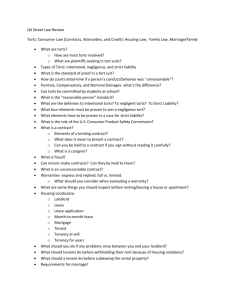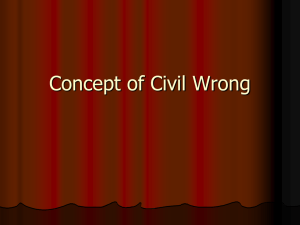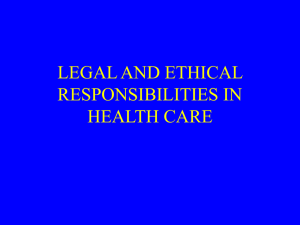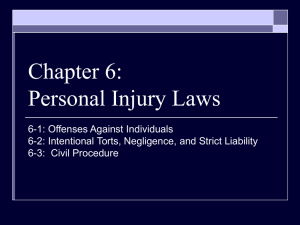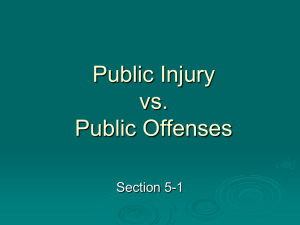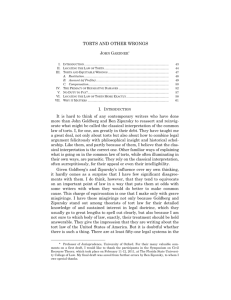Word document
advertisement
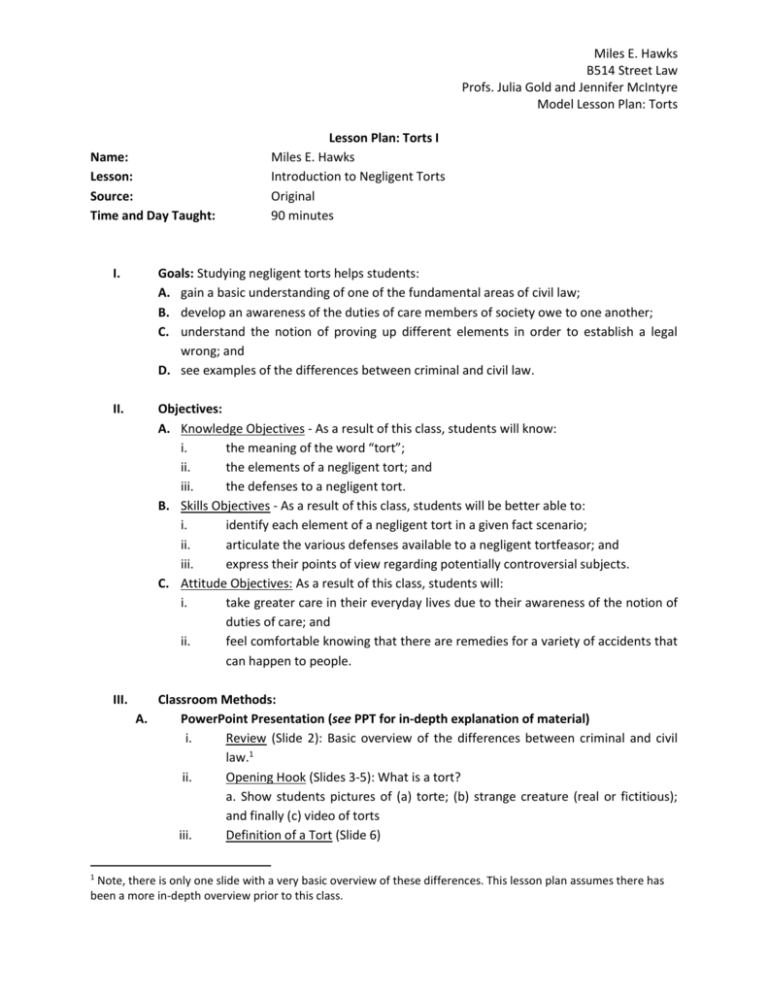
Miles E. Hawks B514 Street Law Profs. Julia Gold and Jennifer McIntyre Model Lesson Plan: Torts Name: Lesson: Source: Time and Day Taught: 1 Lesson Plan: Torts I Miles E. Hawks Introduction to Negligent Torts Original 90 minutes I. Goals: Studying negligent torts helps students: A. gain a basic understanding of one of the fundamental areas of civil law; B. develop an awareness of the duties of care members of society owe to one another; C. understand the notion of proving up different elements in order to establish a legal wrong; and D. see examples of the differences between criminal and civil law. II. Objectives: A. Knowledge Objectives - As a result of this class, students will know: i. the meaning of the word “tort”; ii. the elements of a negligent tort; and iii. the defenses to a negligent tort. B. Skills Objectives - As a result of this class, students will be better able to: i. identify each element of a negligent tort in a given fact scenario; ii. articulate the various defenses available to a negligent tortfeasor; and iii. express their points of view regarding potentially controversial subjects. C. Attitude Objectives: As a result of this class, students will: i. take greater care in their everyday lives due to their awareness of the notion of duties of care; and ii. feel comfortable knowing that there are remedies for a variety of accidents that can happen to people. III. Classroom Methods: A. PowerPoint Presentation (see PPT for in-depth explanation of material) i. Review (Slide 2): Basic overview of the differences between criminal and civil law.1 ii. Opening Hook (Slides 3-5): What is a tort? a. Show students pictures of (a) torte; (b) strange creature (real or fictitious); and finally (c) video of torts iii. Definition of a Tort (Slide 6) Note, there is only one slide with a very basic overview of these differences. This lesson plan assumes there has been a more in-depth overview prior to this class. Miles E. Hawks B514 Street Law Profs. Julia Gold and Jennifer McIntyre Model Lesson Plan: Torts iv. v. vi. vii. a. Provide students with multiple definitions of “tort”. Examples include (a) Black’s Law Dictionary; (b) laymen’s terms; or (c) definition in Street Law textbook. Torts: Fact or Fiction? (Slide 7): Provide students with several actual tort claims and poll the students as to whether they believe the events underlying the claim actually happened. Types of Torts (Slide 8): a. Explain that there are a wide variety of torts. b. Provide several examples of actual, but unbelievable torts, and poll students as to whether they think the tort happened or not. c. Explain that torts can be broadly classified as negligent (injury results from an actor’s negligent behavior), intentional (injury results from an actor’s intentional behavior) or strict liability torts (applies to activities that have been deemed so dangerous that an actor is liable if there is an injury, regardless of why it happened, e.g. blasting with dynamite). Elements of a Negligent Tort (Slide 9) a. Duty (Slides 10-11): Explain the basic concept of duty and exercising due care. Ask students to give examples of the duty of due care for a number of individuals (e.g., lifeguard, owner of aggressive dog, etc.). b. Breach (Slide 12): Explain the basic concept of breach. c. Causation (Slides 13-20): Explain that there are two types of causation, causation in fact and proximate cause, both of which need to be shown for there to be a tort. Explain the difference between the two types of causation, why proximate cause is more difficult to determine and some of the basic proximate cause theories. Next choose several students to act out the different roles in a series of hypotheticals. The hypotheticals are designed to get the students to think about the limits of proximate cause. Therefore, in all of the hypotheticals it can be assumed that Ken Griffey, Jr. had a duty, which he breached and this was cause in fact for the relevant injuries. After each hypothetical stop the action and ask students to tell you whether there was proximate cause or not and explain the rationales for their answers. d. Damages (Slides 21-22): Explain to students the basic idea of damages, i.e. that all injuries can be compensated with some monetary amount. Defenses to a Negligent Tort (Slide 23): a. Contributory Negligence – the negligence of the plaintiff contributed to the plaintiff’s injury so damages should be denied. b. Comparative Negligence – the negligence of the plaintiff contributed to the plaintiff’s injury so damages should be reduced accordingly or denied. Miles E. Hawks B514 Street Law Profs. Julia Gold and Jennifer McIntyre Model Lesson Plan: Torts c. Assumption of Risk – the plaintiff consented to engage in certain activity that plaintiff knew carried certain risks and therefore damages should be denied. d. Illegality – the plaintiff was engaged in an illegal activity when plaintiff was injured so damages should be denied. IV. Evaluation A. Group Hypos (see attached) i. Pass out Torts Hypos Worksheet and have students break into groups of five. ii. Have students read the hypos and discuss whether the fact scenarios represent a tort. If not, what elements are missing? If so, are there any defenses? iii. If you are crunched for time assign each group one fact pattern to discuss. iv. Have the groups share their thoughts on their fact pattern. V. Assignment A. Position Paper i. Write a one-page position paper in response to one of the following: a. In determining damages for a wrongful death one method of calculating damages is lost wages, i.e. the amount of money that the dead person would have been expected to have earned over his or her lifetime. The result is that the survivors of high earners, such as bankers, receive more than survivors of low earners, such as waitresses. Do you think this is fair? Why or why not? b. Some states have placed damage caps on certain tort claims. In other words, no matter how bad a plaintiff’s injury caused by an accident is, they can only recover up to a certain amount of money. The rationale behind this is that society does not want to force a defendant into bankruptcy because s/he caused an accident. The result can be that an injured plaintiff does not receive enough money to cover the actual losses s/he suffered. Do you think this is fair? Why or why not? Miles E. Hawks B514 Street Law Profs. Julia Gold and Jennifer McIntyre Model Lesson Plan: Torts Torts Hypos Worksheet Instructions: After you read the following scenarios, discuss with your group (a) what possible negligent torts have occurred and (b) whether all the elements of a negligent tort are present for each tort. If not, what elements are missing? If so, does the tortfeasor have any possible defenses? 1. Jenny is driving her car and rocking out to loud music. She does not hear the siren from the ambulance driving down her lane until the ambulance is just 15 feet from her. As soon as she notices the ambulance she swerves to the side of the road without checking her blind spot. She runs into Michael who was in the bicycle lane next to her. 2. Ted is driving down 15th Avenue on a bright sunny day. He drives through the intersection at 45th Street because he has a green light. Unfortunately, a truck driving east on 45th Street runs the red light and crashes into the side of Ted’s car. Ted has nitro boosters in his car that explode on impact. Miraculously, neither Ted nor the driver of the truck is injured, although there is severe property damage, but shrapnel from Ted’s car hits a pedestrian and cuts his leg and strikes a person’s dog killing it. Furthermore, an old man walking out of the Burke Museum hears the explosion and the shock causes him to suffer a heart attack. 3. Steven received a ticket to a Mariners’ game for his birthday. He is very excited because even though the Mariners are a continuously disappointing team, he feels that this year is their year. He is sitting in the right field stands. In the third inning the unthinkable happens; Jose Vidro hits a pitch that looks like it’s going to be a home run. Steven leans on the railing on the right field fence hoping to catch the ball. Just before the ball reaches his hands the weight of the people pushing him from behind causes the railing to buckle and Steven falls into right field and breaks his arm. To make matters worse, the ball turned out to be an otherwise routine fly. 4. John, a cabinet maker, was heating glue over a gasoline fire. At some point the glue boiled over out of the pot and caught fire. John tried to put it out by throwing water on it, but that just caused the fire to spread. One thing led to another and the fire didn’t stop at the cabinet shop, but instead burned down most of Seattle. 5. Anne and Sue, two seven-year olds, were playing in Anne’s backyard. Anne found her father’s golf clubs and the girls took turns swinging the clubs. When it came time to swing the seven iron, Anne didn’t notice that Sue had walked right behind her and when she swung the club it went around and split Sue’s skull. Sue needed some stitches, but she was otherwise alright.
